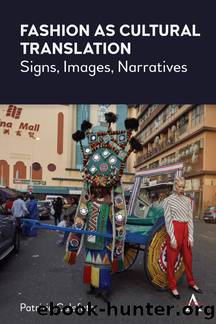Fashion as Cultural Translation: Signs, Images, Narratives (Anthem Studies in Fashion, Dress and Visual Cultures) by Patrizia Calefato

Author:Patrizia Calefato [Calefato, Patrizia]
Language: eng
Format: azw3
Publisher: Anthem Press
Published: 2021-01-29T16:00:00+00:00
In our epoch, objects, places and bodies are writing surfaces â they are covered in texts, names and brands. These signs have developed an increasingly important role in the modes of production of our times. The function of writing is no longer that of marking objects with âdistinctiveâ features, namely, to detach them from and oppose them to other objects, for example, like a sign indicating the name of a road or a label indicating the contents of a jar. Writing has developed a much more ambitious task: to embody a vision, a project, a tale. As the figure of writing, âin name appears the essential law of languageâ (Benjamin 1996, 65).
The nineteenth-century Jewish mysticism scholar Gershom Scholem (1996) dedicated a central part of his research to the role of the name of God in Kabbalistic culture. This is an essential role if we accept the mystical hypothesis that the Torah, the sacred text of the Jewish tradition, might be â as Scholem explains â the expression of the infinite might of God, concentrated in his name. The power that monotheistic mysticism gives to the holy name can be a model for âmundaneâ and secularised interpretations. The condition, of course, is that one should be able to find in the world something that can exist in the place of the name of God, namely, something with a similar ability to continuously create meaning from the incisive energy of a single sign. As the name of God in the text of the Torah, it should be a sign that can function as the central idea within the intricate fabric of a culture. I suggest the hypothesis that today, this sign might be represented by a brand.
To explain this hypothesis and apply it to how fashion brands are used, I am going to refer again to Scholemâs research. Doing so helps to sketch the existence in the contemporary world of a figure whose semiotic power is explained as a relationship based on the connection between text and body, understood both as the human body and a social body. Scholem was the first scholar to consider the different handwritten versions of the Book of Splendor (1963) dating back to the mystic circles which predate thirteenth-century Kabbalah. In this treatise, he exposes the technique of wearing a divine name: Godâs secret names are written on a piece of parchment, which is then used to fabricate a jacket with no sleeves and a hat. The mystic wears these clothes and fasts for seven days, avoiding contact with any form of impurity. After this time, he must reach a water surface and âshout the nameâ. If a green figure can be perceived above the water, then the penitent is still impure and must start the ritual of the seven days again, until the figure on the water is perceived as red.
The idea to wear a name with an extraordinary power might not seem absurd today, in the plethoric universe of names that surround us on clothes and accessories in the form of brands, griffs, logos and labels.
Download
This site does not store any files on its server. We only index and link to content provided by other sites. Please contact the content providers to delete copyright contents if any and email us, we'll remove relevant links or contents immediately.
| Anthropology | Archaeology |
| Philosophy | Politics & Government |
| Social Sciences | Sociology |
| Women's Studies |
Born to Run: by Christopher McDougall(7066)
The Leavers by Lisa Ko(6913)
iGen by Jean M. Twenge(5368)
Sapiens by Yuval Noah Harari(5295)
The Kite Runner by Khaled Hosseini(5087)
Spare by Prince Harry The Duke of Sussex(5078)
Machine Learning at Scale with H2O by Gregory Keys | David Whiting(4199)
Bullshit Jobs by David Graeber(4101)
Never by Ken Follett(3800)
Goodbye Paradise(3729)
Livewired by David Eagleman(3686)
Fairy Tale by Stephen King(3226)
A Dictionary of Sociology by Unknown(3032)
Harry Potter 4 - Harry Potter and The Goblet of Fire by J.K.Rowling(2993)
The Social Psychology of Inequality by Unknown(2941)
The Club by A.L. Brooks(2863)
Will by Will Smith(2795)
0041152001443424520 .pdf by Unknown(2786)
People of the Earth: An Introduction to World Prehistory by Dr. Brian Fagan & Nadia Durrani(2702)
